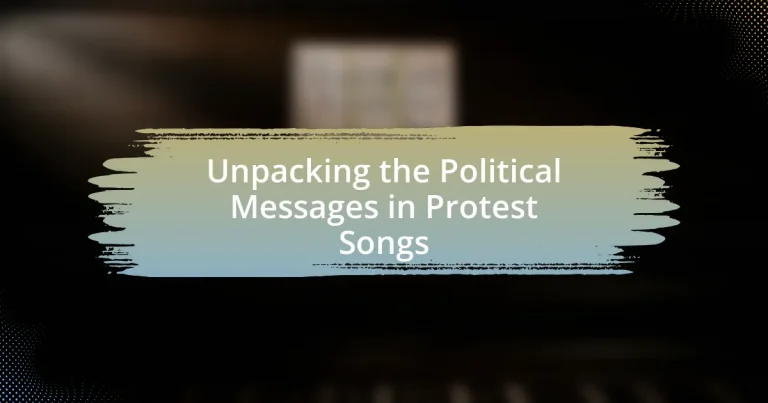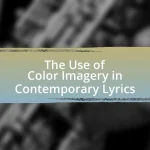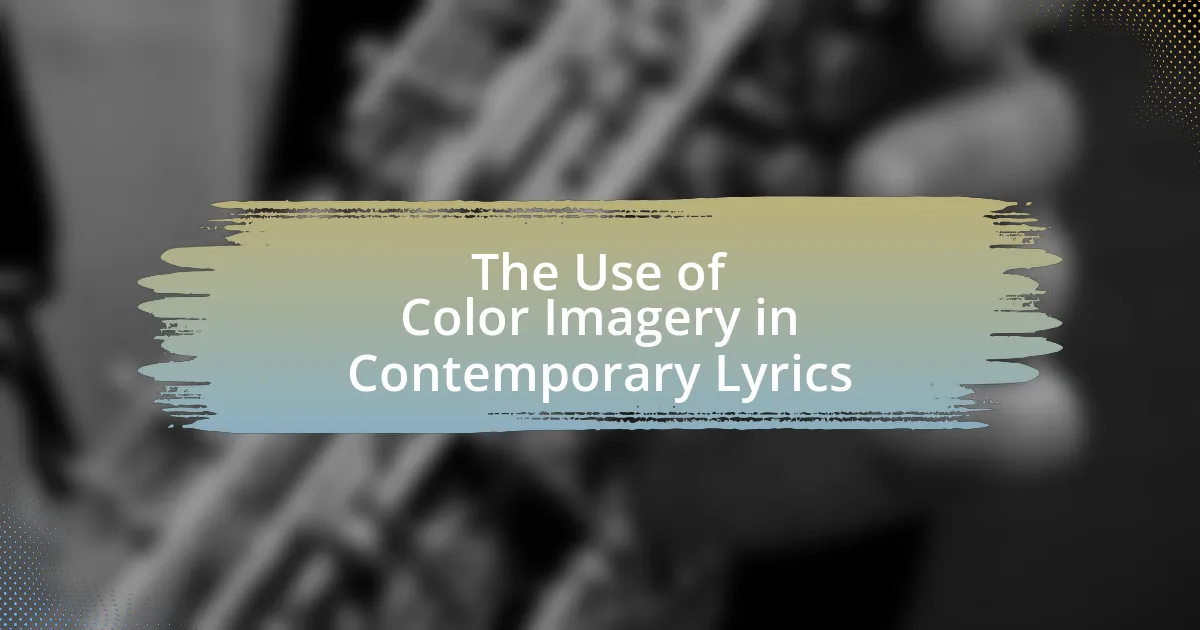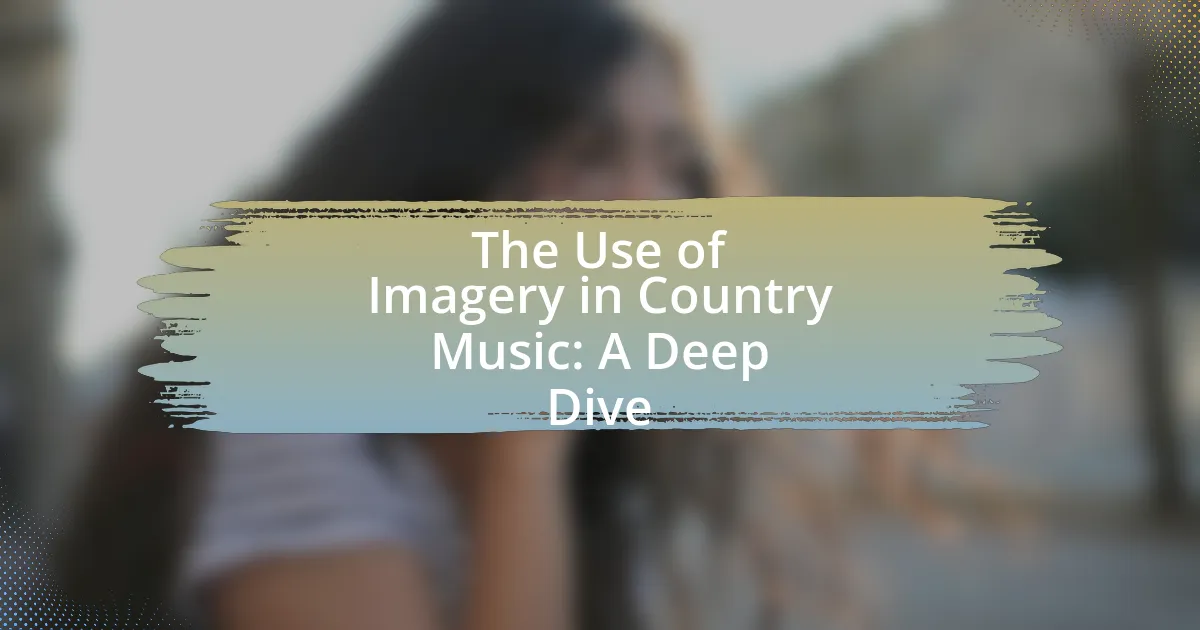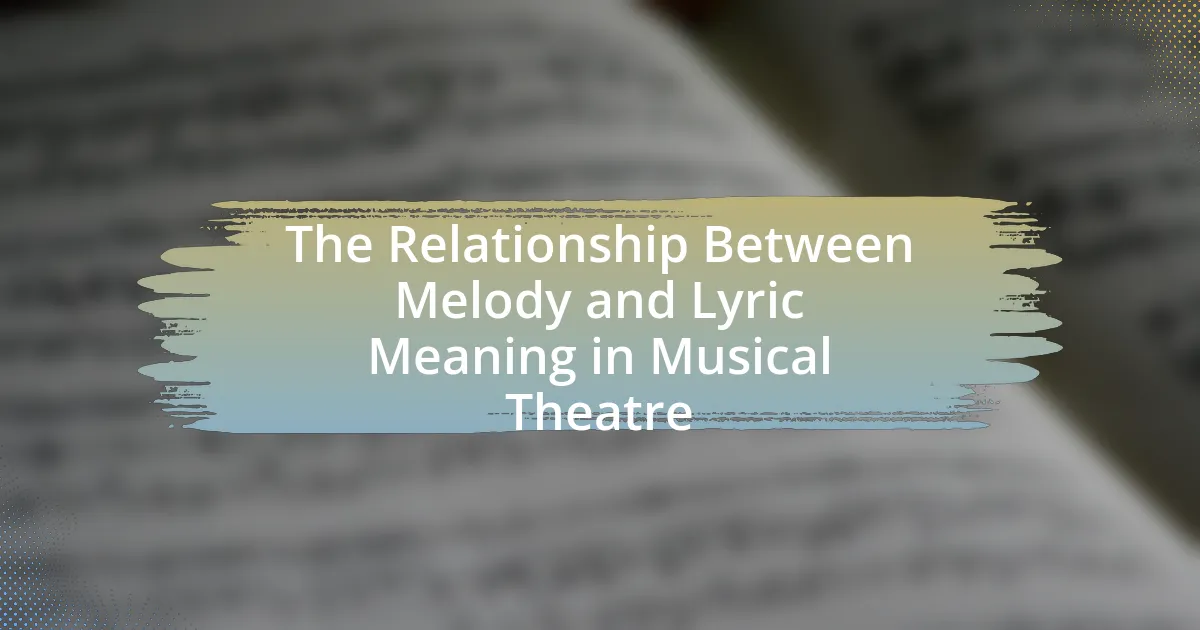The article “Unpacking the Political Messages in Protest Songs” explores how protest songs serve as powerful tools for expressing dissent and advocating for social change. It examines the lyrical elements, musical styles, and cultural contexts that enhance the delivery of political messages, highlighting notable examples and artists who have shaped the genre. The significance of protest songs in mobilizing communities and inspiring action is discussed, along with the techniques that songwriters can use to craft impactful messages. Additionally, the article addresses how contemporary issues are reflected in modern protest music and the strategies artists employ to reach wider audiences.
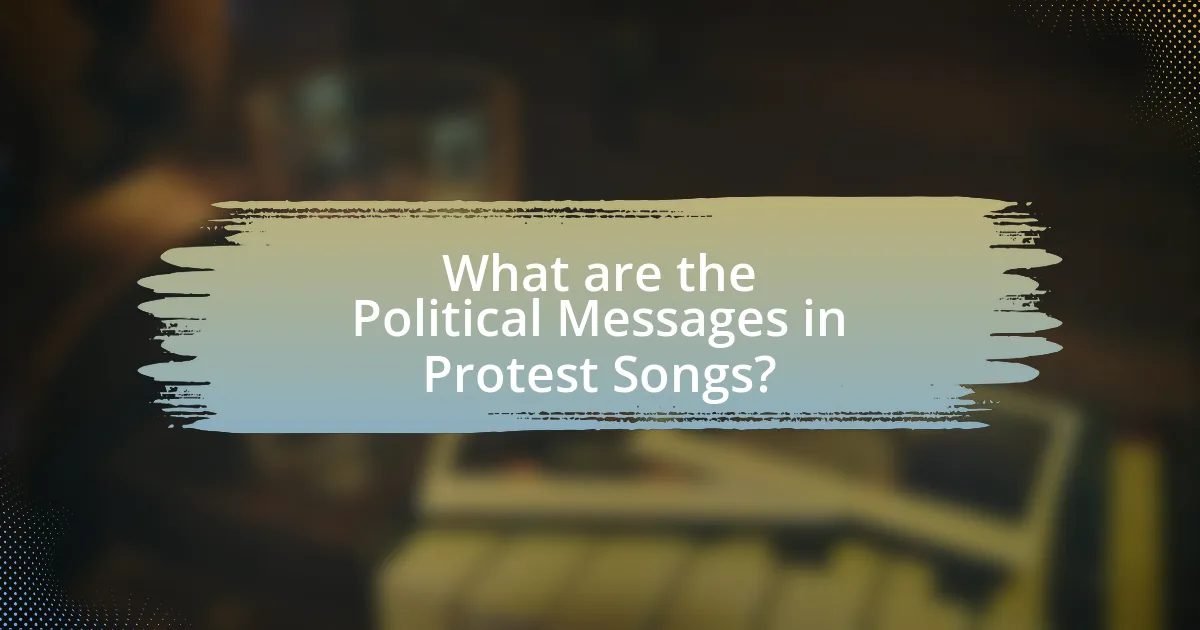
What are the Political Messages in Protest Songs?
Protest songs convey political messages that often address social injustices, advocate for change, and mobilize public sentiment. These songs serve as a medium for expressing dissent against government policies, war, inequality, and civil rights violations. For instance, Bob Dylan’s “The Times They Are a-Changin'” became an anthem for the civil rights movement, urging societal transformation and highlighting the need for political awareness. Similarly, songs like “Fight the Power” by Public Enemy explicitly challenge systemic racism and empower marginalized communities. The effectiveness of protest songs lies in their ability to resonate emotionally with listeners, making complex political issues more accessible and inspiring collective action.
How do protest songs convey political messages?
Protest songs convey political messages through their lyrics, melodies, and cultural context, often addressing social injustices and mobilizing listeners for change. These songs utilize powerful imagery and emotional resonance to articulate dissent, as seen in tracks like “The Times They Are a-Changin'” by Bob Dylan, which became an anthem for the civil rights movement. The repetitive and catchy nature of protest songs enhances their memorability, allowing messages to spread widely and resonate with diverse audiences. Historical examples, such as “Fight the Power” by Public Enemy, illustrate how protest songs can challenge authority and inspire collective action, reinforcing their role as tools for political expression and social mobilization.
What lyrical elements are commonly used to express political themes?
Lyrical elements commonly used to express political themes include imagery, symbolism, and repetition. Imagery creates vivid mental pictures that convey political messages, such as the use of “tears of the oppressed” to evoke empathy for marginalized groups. Symbolism allows artists to represent complex ideas through objects or actions, like the “flag” symbolizing national identity or protest. Repetition emphasizes key phrases or ideas, reinforcing the urgency of political issues, as seen in songs that repeatedly chant calls for justice or change. These elements effectively engage listeners and provoke thought about societal issues.
How do musical styles influence the delivery of political messages?
Musical styles significantly influence the delivery of political messages by shaping the emotional tone and accessibility of the content. For instance, genres like folk music often utilize simple melodies and relatable lyrics, making complex political issues more approachable for a wider audience, as seen in the protest songs of the 1960s, which mobilized public sentiment against the Vietnam War. In contrast, genres such as hip-hop employ rhythmic complexity and cultural references that resonate with specific communities, effectively conveying messages of social justice and resistance, as demonstrated by artists like Kendrick Lamar, whose work addresses systemic racism and inequality. The choice of musical style thus directly impacts how audiences perceive and engage with political messages, enhancing their emotional resonance and potential for mobilization.
Why are protest songs significant in political movements?
Protest songs are significant in political movements because they serve as powerful tools for social change and collective expression. These songs often encapsulate the sentiments of marginalized groups, providing a voice to their struggles and aspirations. For instance, during the Civil Rights Movement in the United States, songs like “We Shall Overcome” became anthems that united activists and communicated their demands for equality and justice. Additionally, research indicates that music can enhance emotional engagement and mobilize individuals, making protest songs effective in rallying support and fostering solidarity among participants in political movements.
What historical contexts have shaped the impact of protest songs?
Protest songs have been significantly shaped by historical contexts such as the Civil Rights Movement, the Vietnam War, and social justice movements. During the Civil Rights Movement of the 1960s, songs like “We Shall Overcome” became anthems for change, reflecting the struggle against racial injustice and mobilizing communities. The Vietnam War era saw artists like Bob Dylan and Joan Baez use their music to express anti-war sentiments, influencing public opinion and galvanizing protests. Additionally, contemporary movements such as Black Lives Matter have inspired new protest songs that address systemic racism and police brutality, demonstrating the ongoing relevance of music in social activism. These contexts illustrate how protest songs serve as powerful tools for political expression and societal change.
How do protest songs mobilize communities and inspire action?
Protest songs mobilize communities and inspire action by fostering a shared sense of identity and purpose among listeners. These songs often encapsulate the struggles and aspirations of a group, creating emotional resonance that unites individuals around a common cause. For example, during the Civil Rights Movement, songs like “We Shall Overcome” became anthems that not only articulated the desire for equality but also galvanized collective action, leading to organized protests and demonstrations. Research indicates that music can enhance group cohesion and motivate individuals to participate in social movements, as evidenced by the significant role of protest songs in various historical contexts, such as anti-war protests and labor movements.
What are some notable examples of protest songs and their messages?
Notable examples of protest songs include “Blowin’ in the Wind” by Bob Dylan, which questions civil rights and peace, and “Fight the Power” by Public Enemy, which addresses racial inequality and empowerment. “Fortunate Son” by Creedence Clearwater Revival critiques the Vietnam War and class disparity, while “Killing in the Name” by Rage Against the Machine condemns institutional racism and police brutality. Each of these songs conveys powerful messages that resonate with social justice movements, reflecting the struggles and aspirations of marginalized communities.
Which artists have made significant contributions to the genre?
Artists such as Bob Dylan, Joan Baez, and Public Enemy have made significant contributions to the genre of protest songs. Bob Dylan’s “The Times They Are a-Changin'” became an anthem for the civil rights movement in the 1960s, reflecting societal changes and urging political action. Joan Baez, known for her folk music, used her platform to advocate for peace and civil rights, notably with her rendition of “We Shall Overcome.” Public Enemy’s “Fight the Power” addressed racial inequality and social injustice, becoming a pivotal song in hip-hop’s role in activism. These artists exemplify how music can convey powerful political messages and inspire movements.
What specific events or issues have been addressed in these songs?
Protest songs have addressed specific events and issues such as civil rights movements, anti-war sentiments, social justice, and economic inequality. For instance, “The Times They Are a-Changin'” by Bob Dylan reflects the civil rights movement and the demand for social change during the 1960s. Similarly, “Fortunate Son” by Creedence Clearwater Revival critiques the Vietnam War and the class disparities in who was sent to fight. These songs serve as cultural artifacts that encapsulate the sentiments and struggles of their respective eras, providing a voice to marginalized communities and highlighting systemic injustices.
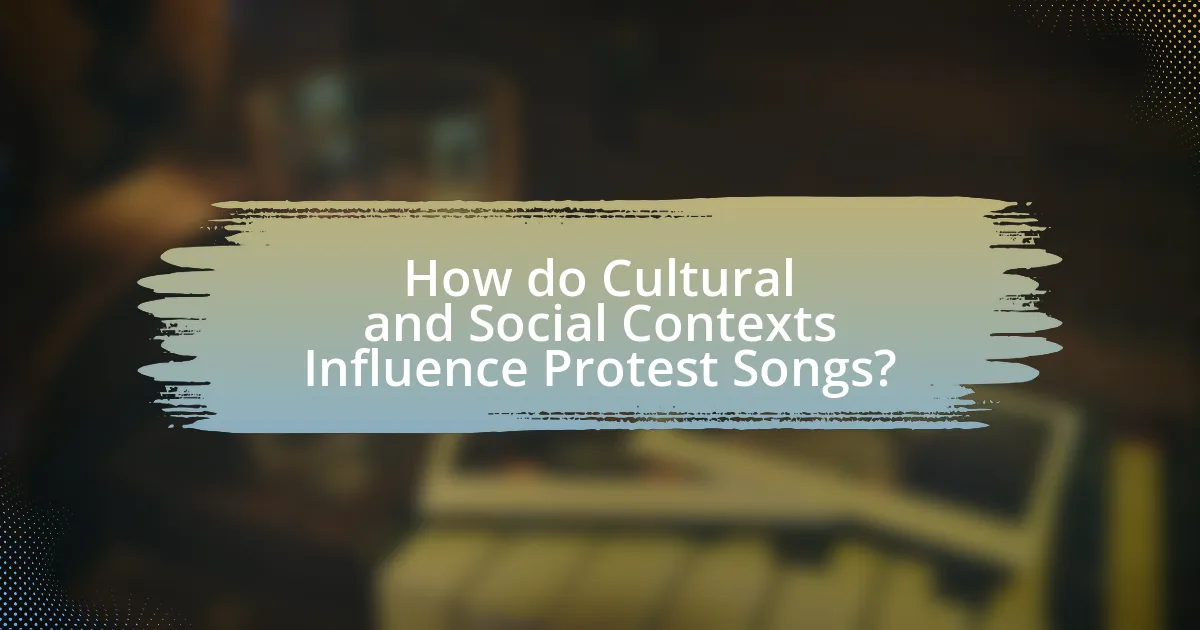
How do Cultural and Social Contexts Influence Protest Songs?
Cultural and social contexts significantly influence protest songs by shaping their themes, language, and reception. For instance, during the Civil Rights Movement in the United States, songs like “We Shall Overcome” emerged as anthems reflecting the struggle for racial equality, resonating deeply with the social climate of the time. The lyrics and melodies often draw from cultural traditions, such as folk music or spirituals, which enhance their emotional impact and relatability. Additionally, the political landscape, including government policies and societal attitudes, directly affects the content of protest songs; for example, the anti-war movement in the 1960s produced songs like “Fortunate Son” by Creedence Clearwater Revival, critiquing social inequalities related to military service. These examples illustrate how cultural and social contexts not only inform the creation of protest songs but also determine their effectiveness in mobilizing public sentiment and action.
What role does culture play in shaping protest music?
Culture plays a crucial role in shaping protest music by influencing its themes, styles, and messages. Cultural contexts, such as historical events, social movements, and collective identities, inform the content and emotional resonance of protest songs. For instance, during the Civil Rights Movement in the United States, artists like Billie Holiday and Bob Dylan used their music to address racial injustice and inequality, reflecting the cultural urgency of the time. Additionally, cultural elements such as language, musical genres, and local traditions shape how protest music is created and received, making it a powerful tool for social change and community solidarity.
How do different cultures interpret and respond to protest songs?
Different cultures interpret and respond to protest songs based on their unique historical, social, and political contexts. For instance, in the United States, protest songs like “This Land Is Your Land” by Woody Guthrie have been embraced as anthems for social justice movements, reflecting the struggles against inequality and advocating for civil rights. In contrast, in South Africa, songs like “Nkosi Sikelel’ iAfrika” served as powerful tools during the anti-apartheid movement, symbolizing unity and resistance against oppression.
Cultural responses can also vary; in some societies, protest songs are celebrated and integrated into national identity, while in others, they may face censorship or backlash from authorities. For example, in China, protest songs are often suppressed, reflecting the government’s control over artistic expression, whereas in Brazil, songs like “Cazuza’s Exagerado” have been pivotal in mobilizing public sentiment against corruption and injustice. These variations illustrate how cultural interpretations and responses to protest songs are deeply intertwined with local histories and political climates.
What social movements have influenced the creation of protest songs?
Social movements that have influenced the creation of protest songs include the Civil Rights Movement, the anti-Vietnam War Movement, and the Women’s Liberation Movement. The Civil Rights Movement, particularly in the 1960s, inspired songs like “We Shall Overcome,” which became an anthem for racial equality and justice. The anti-Vietnam War Movement led to the emergence of songs such as “Fortunate Son” by Creedence Clearwater Revival, expressing opposition to the war and the draft. Additionally, the Women’s Liberation Movement spurred songs like “I Am Woman” by Helen Reddy, which highlighted gender equality and women’s rights. These movements provided the social context and urgency that fueled the creation of impactful protest songs, reflecting the struggles and aspirations of their respective causes.
How do protest songs reflect societal changes over time?
Protest songs reflect societal changes over time by capturing the sentiments, struggles, and aspirations of specific historical moments. For instance, during the Civil Rights Movement in the 1960s, songs like “We Shall Overcome” became anthems that articulated the demand for racial equality and justice, resonating with the collective consciousness of the era. Similarly, the anti-war movement during the Vietnam War saw songs such as “Fortunate Son” by Creedence Clearwater Revival critique social inequalities and the impact of war on marginalized communities. These songs serve as cultural artifacts that not only document the prevailing social issues but also galvanize public opinion and inspire activism, illustrating how music can mirror and influence societal transformations.
What trends can be observed in protest music across different eras?
Protest music has evolved through various trends across different eras, reflecting the socio-political climate of each period. In the 1960s, folk music became a prominent vehicle for civil rights and anti-war sentiments, exemplified by artists like Bob Dylan and Joan Baez, who used their lyrics to challenge authority and promote social change. The 1970s saw the rise of punk rock, with bands like The Clash and Sex Pistols expressing disillusionment with government and societal norms through aggressive and raw sound.
In the 1980s and 1990s, hip-hop emerged as a powerful form of protest music, with artists like Public Enemy and N.W.A addressing systemic racism and police brutality, thereby amplifying marginalized voices. The 2000s and beyond have witnessed a resurgence of protest music across genres, including pop and indie, with artists like Beyoncé and Kendrick Lamar tackling issues such as racial inequality and social justice, often using their platforms to mobilize activism.
These trends illustrate how protest music adapts to cultural shifts while maintaining its core function of challenging injustice and inspiring collective action.
How do contemporary issues find expression in modern protest songs?
Contemporary issues find expression in modern protest songs through direct lyrics that address social injustices, political corruption, and systemic inequality. For example, songs like “This Is America” by Childish Gambino critique gun violence and racism in the United States, using vivid imagery and powerful metaphors to convey urgency and emotion. Additionally, artists such as Billie Eilish in “Your Power” highlight themes of abuse and exploitation, reflecting societal concerns about power dynamics. These songs resonate with listeners by articulating shared frustrations and mobilizing collective action, demonstrating the role of music as a catalyst for social change.
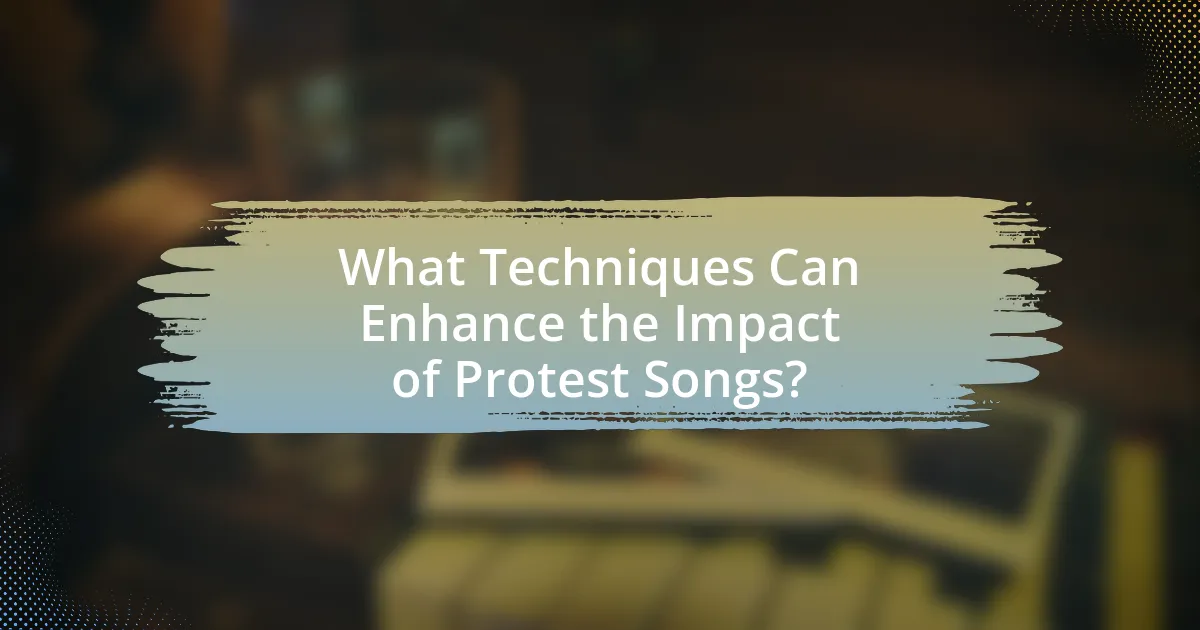
What Techniques Can Enhance the Impact of Protest Songs?
Techniques that can enhance the impact of protest songs include the use of powerful lyrics, memorable melodies, and strategic repetition. Powerful lyrics convey strong emotions and articulate specific grievances, making the message relatable and urgent. For instance, Bob Dylan’s “The Times They Are a-Changin'” effectively captures the spirit of social change through evocative language. Memorable melodies ensure that the song remains in listeners’ minds, facilitating wider dissemination and sing-along participation, as seen in “We Shall Overcome,” which became an anthem for the Civil Rights Movement. Strategic repetition of key phrases reinforces the message, making it more impactful and easier to remember, a technique effectively utilized in songs like “Fight the Power” by Public Enemy. These techniques collectively amplify the emotional resonance and reach of protest songs, thereby enhancing their overall impact.
How can songwriters effectively craft political messages?
Songwriters can effectively craft political messages by using clear, relatable language and strong imagery to convey their ideas. This approach allows them to connect emotionally with their audience, making complex political issues more accessible. For instance, Bob Dylan’s “The Times They Are a-Changin'” employs straightforward lyrics that resonate with listeners, encouraging social change during the 1960s civil rights movement. Additionally, incorporating personal stories or experiences can enhance the authenticity of the message, as seen in songs like “Fight the Power” by Public Enemy, which addresses systemic racism and empowerment. By blending personal narratives with broader political themes, songwriters can create impactful protest songs that inspire action and reflection.
What storytelling techniques resonate with audiences in protest songs?
Protest songs resonate with audiences through storytelling techniques such as personal narratives, vivid imagery, and emotional appeals. Personal narratives allow listeners to connect with individual experiences that reflect broader social issues, making the message relatable and impactful. Vivid imagery paints a clear picture of the struggles and injustices being addressed, enhancing the emotional weight of the song. Emotional appeals, including the use of powerful language and evocative melodies, evoke feelings of empathy and urgency, prompting listeners to engage with the cause. These techniques have been effective in historical contexts, such as Bob Dylan’s “The Times They Are a-Changin’,” which utilized personal stories and strong imagery to inspire social change during the civil rights movement.
How can the use of imagery and metaphor strengthen a song’s message?
The use of imagery and metaphor can significantly strengthen a song’s message by creating vivid mental pictures and emotional connections that resonate with listeners. Imagery allows songwriters to paint scenes that evoke specific feelings or thoughts, making abstract concepts more tangible. For example, in protest songs, metaphors can encapsulate complex social issues, such as using a “broken window” to symbolize societal decay, which can provoke a stronger emotional response and encourage reflection on the underlying problems. This technique enhances the song’s impact by making the message more relatable and memorable, ultimately fostering a deeper understanding of the political themes being addressed.
What strategies can artists use to reach wider audiences?
Artists can reach wider audiences by leveraging social media platforms, collaborating with other artists, and engaging in community events. Social media allows artists to share their work instantly with a global audience; for instance, platforms like Instagram and TikTok have millions of active users, providing a vast potential reach. Collaborations with other artists can introduce their music to new fan bases, as seen with successful partnerships in the music industry that often lead to increased visibility and streams. Additionally, participating in community events, such as local festivals or protests, helps artists connect with audiences on a personal level, fostering a sense of community and shared purpose. These strategies have been proven effective in expanding an artist’s reach and influence in the music scene.
How can social media amplify the reach of protest songs?
Social media amplifies the reach of protest songs by enabling rapid sharing and engagement among diverse audiences. Platforms like Twitter, Facebook, and Instagram allow users to disseminate songs widely, often leading to viral trends that can reach millions within hours. For instance, the protest song “This Is America” by Childish Gambino gained significant traction on social media, with millions of views and shares, highlighting issues of gun violence and racism. This rapid dissemination is supported by the ability to create hashtags, which can unify discussions and mobilize listeners around specific causes, further enhancing visibility and impact.
What role do live performances play in the effectiveness of protest music?
Live performances significantly enhance the effectiveness of protest music by fostering a communal experience that amplifies the emotional impact of the message. When artists perform live, they create an immediate connection with the audience, allowing for collective engagement and shared emotional resonance, which can galvanize support for social movements. Historical examples, such as the 1969 Woodstock Festival, illustrate this; the event became a pivotal moment for anti-war sentiment, as live performances by artists like Joan Baez and Jimi Hendrix united thousands in a shared cause. Additionally, research indicates that live music can increase the likelihood of audience members participating in activism, as seen in studies showing that concert-goers are more likely to engage in political discussions and actions post-performance. Thus, live performances serve as a powerful catalyst for mobilizing social change through protest music.
What are best practices for creating impactful protest songs?
To create impactful protest songs, focus on clear messaging, emotional resonance, and cultural relevance. Clear messaging ensures that the song’s core message is easily understood, which is crucial for mobilizing listeners. Emotional resonance engages the audience on a personal level, making them more likely to connect with the cause. Cultural relevance ties the song to current events or social movements, enhancing its significance and reach. For example, songs like “Fight the Power” by Public Enemy effectively combined these elements, addressing racial injustice while resonating with the cultural context of the time.
